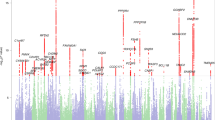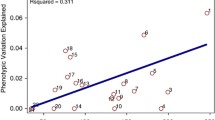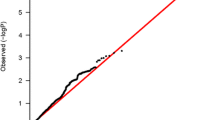Abstract
There is evidence for genetic contributions to reading disability, but the phenotypic heterogeneity associated with the clinical diagnosis may make identification of the underlying genetic basis difficult. In order to elucidate distinct phenotypic features that may be contributing to the genotypic heterogeneity, we assessed the familial aggregation patterns of Verbal IQ and 24 phenotypic measures associated with dyslexia in 102 nuclear families ascertained through probands in grades 1 through 6 who met the criteria for this disorder. Correlations between relatives were computed for all diagnostic phenotypes, using a generalized estimating equation (GEE) approach. GEE is a recently developed semiparametric method for handling correlated data. The method is robust to model misspecification and flexible in adjusting for the subjects' characteristics and pedigree sizes as well as for the ascertainment process, while estimating the correlations between related subjects. The Nonword Memory (NWM) subtest of a prepublication version of the Comprehensive Test of Phonological Processing (CTOPP) and Phonemic Decoding Efficiency (PDE) subtest of a prepublication version of the Test of Word Reading Efficiency (TOWRE) showed correlation patterns in relatives that are strongly supportive of a genetic basis. The Wechsler Scale Digit Span, the Word Attack subtest of the Woodcock Reading Mastery Test—Revised, and the Spelling subtest of the Wide Range Achievement Test—Third Edition had slightly weaker evidence of a genetic basis. Five additional phenotypes (the Spelling subtest of the Wechsler Individual Achievement Test, the Accuracy, Rate, and Comprehension subtests of the Gray Oral Reading Test—Third Edition, and Rapid Automatized Naming of Letters and Numbers) gave suggestive evidence of such a pattern. The results cross-validate in that evidence for a pattern consistent with a genetic basis was obtained for two measures of phonological short-term memory (CTOPP Nonword Memory and WISCIII or WAIS-R Digit Span), for two measures of phonological decoding (WRMT-R Word Attack and TOWRE Phonemic Decoding Efficiency), and for two measures of spelling from dictation (WRAT-3 Spelling and, to a lesser extent, WIAT Spelling). These measures are thus good candidates for more sophisticated segregation analyses that can formulate models for incorporation into linkage analyses.
Similar content being viewed by others
REFERENCES
Berninger, V. (1994). Reading and Writing Acquisition. A Developmental Neuropsychological Disorder, W. C. Brown & Benchmark, Madison WI.
Berninger, V. (2000a). Dyslexia, the invisible, treatable disorder: The story of Einstein's Ninja Turtles. Learn. Disabil. Q. 23:175–195.
Berninger, V. (2000b). Development of language by hand and its connections to language by ear, mouth, and eye. Topics Lang. Disord. 20:65–84.
Berninger, V., and Rutberg, J. (1992). Relationship of finger function to beginning writing: Application to diagnosis of writing disabilities. Dev. Med. Child Neurol. 34:155–172.
Berninger, V., et al. (1987). Preventing reading disabilities by assessing and remediating phonemic skills. School Psychol. Rev. 16:553–564.
Berninger, V., Yates, C., and Lester, K. (1991). Multiple orthographic codes in acquisition of reading and writing skills. Read. Writing Interdisc. J. 3:115–149.
Berninger, V., et al. (1994). Developmental skills related to writing and reading acquisition in the intermediate grades: Shared and unique variance. Read. Writing Interdisc. J. 6:161–196.
Berninger, V. W., Abbott, R. D., Thomson, J. B., and Raskind, W. H. (2001). Language phenotype for reading and writing disability: A lifespan approach. Sci. Stud. Read. 5:59–105.
Berninger, V. W., Stage, S., Smith, D., and Hildebrand, D. (2000). Assessment for reading and writing intervention: A 3-tier model for prevention and intervention. In Andrews, J., Janzen, H., and Saklofske, D. (<nt>eds.</nt>), Ability, Achievement, and Behavior Assessment. A Practical Handbook, Academic Press, New York (<nt>in press</nt>).
Bishop, D. V. M., and Adams, J. (1990). A prospective study of the relationship between specific language impairment, phonological disorders and reading retardation. J. Child Psychol. Psychiat. 31:1027–1050.
Bishop, D. V. M., North, T., and Donlan, C. (1996). Nonword repetition as a behavioural marker for inherited language impairment: Evidence from a twin study. J. Child Psychol. Psychiat. 37:391–403.
Bishop, D. V, Bishop S. J., Bright, P., James, C., Delaney, T., and Tallal, P. (1999). Different origin of auditory and phonological processing problems in children with language impairment: Evidence from a twin study. J. Speech Lang. Hear. Res. 42:155–168.
Cardon, L. R., et al. (1994). Quantitative trait locus for reading disability on chromosome 6. Science 266:276–279.
Cardon, L. R., et al. (1995). Quantitative trait locus for reading disability: Correction [letter]. Science 268:1553.
Decker, S., and DeFries, J. (1981). Cognitive ability profiles in families of reading-disabled children. Dev. Med. Child Neurol. 23:217–227.
DeFries, J., Fulker, D., and LaBuda, M. (1987). Evidence for a genetic aetiology in reading disability of twins. Nature 329:537–539.
DeFries, J. C., et al. (1991). Colorado Reading Project: Past, present, and future. Learn. Disabil. 2:37–46.
Denckla, M., and Rudel, R. (1976). Rapid "automatized" naming (R.A.N.): Dyslexia differentiated from other learning disabilities. Neuropsychologia 14:471–479.
Fagerheim, T., et al. (1999). A new gene (DYX3) for dyslexia is located on chromosome 2. J. Med. Genet. 36:664–669.
Falconer, D. S. (1989). Introduction to Quantitative Genetics, Ronald, New York.
Field, L. L., and Kaplan, B. J. (1998). Absence of linkage of phonological coding dyslexia to chromosome 6p23-p21.3 in a large family data set. Am. J. Hum. Genet. 63:1448–1456.
Fisher, S. E., et al. (1999). A quantitative-trait locus on chromosome 6p influences different aspects of developmental dyslexia. Am. J. Hum. Genet. 64:146–156.
Gayán, J., et al. (1999). Quantitative-trait locus for specific language and reading deficits on chromosome 6p. Am. J. Hum. Genet. 64:157–164.
Gilger, J. W. (1991). Differential assortative mating found for academic and demographic variables as a function of time of assessment. Behav. Genet. 21:131–150.
Gilger, J. W., et al. (1994). Commingling and segregation analysis of reading performance in families of normal reading probands. Behav. Genet. 24:345–355.
Goate, A., et al. (1991). Segregation of a missense mutation in the amyloid precursor protein gene with familial Alzheimer's disease. Nature 349:704–706.
Goddard, K. A. B., et al. (1995). Analysis of quantitative risk factors for a common oligogenic disease. Genet. Epidemiol. 12:759–764.
Greenblatt, E., Mattis, S., and Trad, P. (1990). Nature and prevalence of learning disabilities in a child psychiatric population. Dev. Neuropsychol. 6:71–83.
Grigorenko, E. L., et al. (1997). Susceptibility loci for distinct components of developmental dyslexia on chromosomes 6 and 15. Am. J. Hum. Genet. 60:27–39.
Hallgren, B. (1950). Specific dyslexia (congenital word-blindness): A clinical and genetic study. Acta Psychiatr. Neurol. Suppl. 65:1–287.
Levy-Lehad, E., et al. (1995). Candidate gene for the chromosome 1 familial Alzheimer's disease locus. Science 269:973–977.
Liang, K. Y., and Zeger, S. L. (1986). Longitudinal data analysis using generalized linear models. Biometrika 73:13–22.
Liberman, I., Shankweiler, D., Fischer, F., and Carter, B. (1974). Explicit syllable and phoneme segmentation in the young child. J. Exp. Child Psychol. 18:201–212.
Miki, Y., et al. (1994). A strong candidate for the breast and ovarian cancer susceptibility gene BRCA1. Science 266:66–71.
Olson, R., Forsberg, H., and Wise, B. (1994a). Genes, environment, and the development of orthographic skills. In Berninger, V. W. (<nt>ed.</nt>), The Varieties of Orthographic Knowledge I: Theoretical and Developmental Issues, Kluwer Academic, Dordrecht, The Netherlands, pp. 27–71.
Olson, R. K., Forsberg, H. Wise, B., and Rack, J. (1994b). Measurement of word recognition, orthographic, and phonological skills. In Lyon, G. R. (<nt>ed.</nt>), Frames of Reference for the Assessment of Learning Disabilities, Brookes, Baltimore, MD, pp. 243–277.
Olson, R. K., Datta, H., Gayán, J., and DeFries, J. (1999). A behavioral genetic analysis of reading disabilities and component processes. In Klein, R. M., and McMullen, P. A. (eds.), Converging Methods for Understanding Reading and Dyslexia, MIT Press, Cambridge, MA, pp. 133–151.
Pennington, B., et al. (1990). Phonological processing skills and deficits in adult dyslexics. Child Dev. 61:1753–1778.
Pennington, B., et al. (1991). Evidence for a major gene transmission of developmental dyslexia. JAMA 266:1527–1534.
Petryshen, T. L., Kaplan, B. J., and Field, L. L. (1999). Evidence for a susceptibility locus for phonological coding dyslexia on chromosome 6q13-q16.2. Am. J. Hum. Genet. 65:A163.
Schulte-Körne, G., et al. (1996). Familial aggregation of spelling disability. J. Child Psychol. Psychiat. 37:817–822.
Shaywitz, S., et al. (1990). Prevalence of reading disability in boys and girls. JAMA 264:998–1002.
Sherrington, R., et al. (1995). Cloning of a gene bearing missense mutations in early-onset familial Alzheimer's disease. Nature 375:754–760.
Siegel, L. S. (1999). Issues in the definition and diagnosis of learning disabilities: <nt>A perspective on</nt> Gluckenberger v. Boston University. J. Learn. Disabil. 32:350–361.
Smith, C. A. B. (1980). Estimating genetic correlations. Ann. Hum. Genet. 43:265–284.
Stanovich, K. E. (1999). The sociopsychometrics of learning disabilities. J. Learn. Disabil. 32:304–319.
Stanovich, K. E., and Siegel, L. S. (1994). Phenotypic performance profile of children with reading disabilities: A regression-based test of the phonological-core variable difference model. J. Educ. Psychol. 86:24–53.
Stevenson, J., et al. (1987). A twin study of genetic influences on reading and spelling ability and disability. J. Child Psychol. Psychiat. 28:229–247.
Tallal, P., Ross, R., and Curtiss, S. (1989). Familial aggregation in specific language impairment. J. Speech Hear. Disord. 54:167–173.
Torgesen, J. K., Wagner, R. K., and Rashotte, C. A. (1999). Test of Word Reading Efficiency (TOWRE), Pro-Ed, Austin, TX.
Vellutino, F. (1979). Dyslexia, Theory, and Research, MIT Press, Cambridge, MA.
Vellutino, F., Scanlon, D., and Tanzman, M. (1991). Bridging the gap between cognitive and neurological conceptualizations of reading disability. Learn. Indiv. Diff. 3:181–203.
Wagner, R., and Torgesen, J. (1987). The nature of phonological processing and its causal role in the acquisition of reading skills. Psychol. Bull. 101:192–212.
Wagner, R., and Torgesen, J. (1999). Comprehensive Test of Phonological Processing, Pro-Ed, Austin, TX.
Watkins, K. E., Gadian, D. G., and Vargha-Khadem, F. (1999). Functional and structural brain abnormalities associated with a genetic disorder of speech and language. Am. J. Hum. Genet. 65:1215–1221.
Wechsler, D. (1981). Wechsler Adult Intelligence Scale-Revised (WAIS-R), Psychological Corporation, San Antonio, TX.
Wechsler, D. (1991). Wechsler Intelligence Scale for Children-Third Edition (WISC-III), Psychological Corporation, San Antonio, TX.
Wechsler, D. (1992). Wechsler Individual Achievement Test (WIAT), Psychological Corporation, San Antonio, TX.
Wiederholt, J., and Bryant, B. (1992). Gray Oral Reading Test-Third Edition (GORT-3), Psychological Assessment Resources, Odessa, FL.
Wijsman, E. M., and Amos, C. I. (1997). Genetic analysis of simulated oligogenic traits in nuclear and extended pedigrees: Summary of GAW10 contributions. Genet. Epidemiol. 14:719–735.
Wilkinson, G. (1993). Wide Range Achievement Tests-Revised (WRAT-R), Wide Range, Wilmington, DE.
Wolf, M. (1986). Rapid alternating stimulus naming in the developmental dyslexias. Brain Lang. 27:360–379.
Wolf, M., Bally, H., and Morris, R. (1986). Automaticity, retrieval processes, and reading: A longitudinal study in average and impaired reading. Child Dev. 57:988–1000.
Wolff, P. J., and Melngailis, I. (1994). Family patterns of developmental dyslexia: clinical findings. Am. J. Med. Genet. (Neuropsychiatr. Genet.) 54:122–131.
Woodcock, R. (1987). Woodcock Reading Mastery Tests-Revised (WRMT-R), American Guidance Service, Circle Pines, MN.
Woodcock, R., and Johnson, B. (1990). Woodcock-Johnson Psychoeducational Battery-Revised Tests of Achievement, Riverside, Chicago, IL.
Wooster, R., et al. (1995). Identification of the breast cancer susceptibility gene BRCA2. Nature 378:789–792.
Zhao, L. P., Grove, J., and Quiaoit, F. (1992). A method for assessing patterns of familial resemblance in complex human pedigrees, with as application to the nevus-count data in Utah kindreds. Am. J. Hum. Genet. 51:178–190.
Rights and permissions
About this article
Cite this article
Raskind, W.H., Hsu, L., Berninger, V.W. et al. Familial Aggregation of Dyslexia Phenotypes. Behav Genet 30, 385–396 (2000). https://doi.org/10.1023/A:1002700605187
Issue Date:
DOI: https://doi.org/10.1023/A:1002700605187




